Squier has been making low-cost guitars based on Fender designs since 1982. Because their early guitars have now become collector items for some, Squier is seeking to regain some of that magic with their Classic Vibe Series. This latest series was launched to capture the "vibe" of classic Fender designs as opposed to trying to be exact reproductions of vintage models.
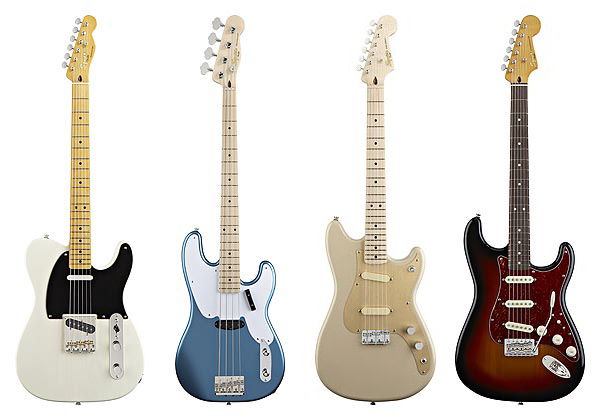 |
The Classic Vibe series is composed of: a 50’s Telecaster, a 50’s & 60’s Stratocaster, a 50’s Duo-Sonic, a 50’s Jazz Bass, and a 50’s & 60’s Precision Bass. In this review we’ll be taking a look at the 60’s Stratocaster, 50’s Telecaster, 50’s Duo-Sonic, and the 50’s Precision Bass. All have MSRP’s at around $499 and street prices of around $299 (the Duo-Sonic is slightly less expensive with a MSRP/Street of $479/$279).
The first thing you’ll notice is that the instruments are all carefully packaged. Once out of the box you’ll get struck by the beauty of the finishes. They certainly look classic. But not only do the models in this review have impeccable finishes, they feel great too. And with the exception of the hardware (Squier’s constant weak point) everything else seems to be right on the money. Here the choice of less expensive hardware is justified as being “vintage” or “classic”. And while some “classic” hardware choices seem to be appropriate (or at least not an issue), some less “vintage” hardware (like enclosed tuning machines) would have been most welcome. But of course that would have jacked up the cost, and considering the price of these models, and their many other strong points, we’re ready to overlook most hardware choices.
The main hardware flaw was found on two of the models (Telecaster & Precision) both of whom had side mounted input jacks. These jacks were very loose regardless of how much I tightened the screws. This problem affected only those instruments with side mounted jacks. The other models tested (Strat & Duo-Sonic) had more or less solid input jacks. Another curious detail is that they all had rather tight knobs compared to their Fender counterparts. I myself like looser knobs to be able to adjust them with my pinky as I’m playing, but this isn’t necessarily a problem for others, and even denotes a certain solidity.
Let’s take a closer look…
50's Telecaster
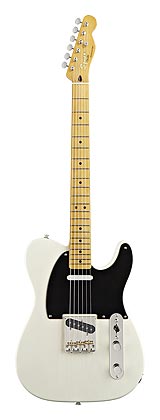 |
This one’s a beauty. It only comes in one color: vintage blond maple (which might not be to everyone’s taste). In reality the color has a creamier hue than in most pictures I’ve seen. As stated before, the finish is impeccable with the wood grain slightly showing through. As for the wood itself, it’s pine. And though some might think this would make for a light guitar, they couldn’t be more wrong. This might be some kind of “exotic” Chinese pine wood, but all that can be said for sure is that this guitar is heavy. It weighs somewhere around 9 pounds! It’s not the heaviest guitar I’ve played, but it’s close. One would wonder why this is so, but in any case this wasn’t really a deterrent for me, but might be for some who don’t like heavy guitars.
As for other specs: the neck is a 1 piece maple (modern C shape, gloss finish), the fingerboard is maple (9.5" radius), with 21 medium jumbo frets (scale 25.5”). As for pickups, it’s got 2 single-coil Alnico – 3 magnets (neck and bridge) . And naturally it’s got: volume/tone controls and a 3 position pickup switch. The hardware is chrome.
The hardware is, not surprisingly, the weak point on this guitar, especially the aforementioned side-mounted input jack. The whole thing seems to be loose and ready to come out of the guitar if you try to move it, no matter how hard you tighten the nut. I would recommend using a guitar stand at all times and avoiding prodding and probing the input jack as much as possible. And as for the pickups: the neck pickup is pretty low and there aren’t any visible screws for altering its height. I’ve read on some forums that the screws are under the pickup cover and don’t have much of an effect either, so this remains a mystery. The bridge pickup, on the other hand, has visible screws that do affect its height.
The maple neck feels great and intonation on the model I tried was just perfect everywhere on the neck. Chords played above the 12the fret were perfectly in tune. Because the guitar is quite heavy, you get the nice impression that it’s quite solid (as opposed to the Duo-Sonic). The knurled control knobs also feel very solid, but as already stated, are a little too difficult to turn for me. I don’t particularly care for the pick guard (looks a little cheap, is too thick, and gets frayed on the edges), but it’s not a big deal and can be easily changed.
Acoustically, the guitar sounds pretty good and resonates nicely. When it’s plugged in you immediately get that Telecaster sound with just a few exceptions. First of all the neck pickup doesn’t seem to have as much of that chime or clear sound that we’re used to hearing from a Tele. Also the level generated by the pickups seems to be slightly lower than that of a Standard American Telecaster (check out the video). Apart from that, it sounds really good and more or less what you’d expect a Telecaster to sound like. It definitely sounds better than some “Made in Mexico” Teles I’ve played, and even compares with some under-par “Made in America” Teles I’ve come across. Considering the price, it’s definitely worth a try. And considering where it’s made, you’ll need to try out the model you’ll be buying “before” you buy (more on that later)
Check out this video to see it in action and hear what it sounds like. We also compare it with a Fender US Standard Telecaster.
50's Duo-Sonic
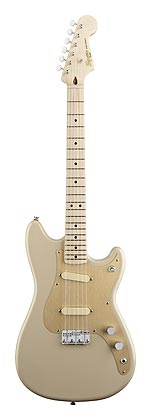 |
The Duo-sonic was first introduced by Fender in 1956 as an affordable student model in 3/4 size. It was revised in 1959 but later discontinued around 1969. Because it’s something of a rarity, this is probably the model that most people are curious about.
As for its specs: the body is made from basswood, the neck is a 1-piece maple (“C” shape), 21 medium-jumbo frets (scale length 24”- 610 mm), 2 single-coil pickups with Alnico 5 magnets (neck & bridge). It’s also got a 3 position pick-up switch, top-load hardtail bridge with 3 barrel saddles, and vintage style tuning machines with white plastic buttons. The hardware is all in chrome.
Just like the other models, the finish is impeccable, but like the Telecaster, it only comes in one color (Desert Sand). I personally like the color, and I think the gold-colored aluminum pickguard looks particularly nice. Because it’s got a slightly smaller body and is made from basswood, it’s very light (night and day when compared to the Telecaster). The short scale neck gives it interesting playability that might take some getting used to for some. I quite like the shorter neck, and all advantages it brings (especially being able to bend notes up a 4th and sometimes even more).
Though I love the feel, playability, look, and sound of this guitar, there were, regretfully, a few issues with intonation and the neck. It seems to be a hit or miss thing (like with all Chinese made products) since from what I’ve read on various forums, others didn’t seem to have these problems with their Duo-Sonics. On the guitar I tested it was impossible to get the thing perfectly in tune. If the open C chord was in tune, then the open D chord sounded horrible, and vice versa. Plus the frets were very deep which meant that I could bend a note up almost a ½ step by just pressing the string down all the way to the wood. The shorter scale neck is probably in part responsible for this, but still…And if that wasn’t enough, the first fret of the high E string was buzzing slightly. The fact that there’s only three saddles instead of six doesn’t help either. As I said, this is regretful, (and no doubt just a bad model) because I really like this guitar in every other way.
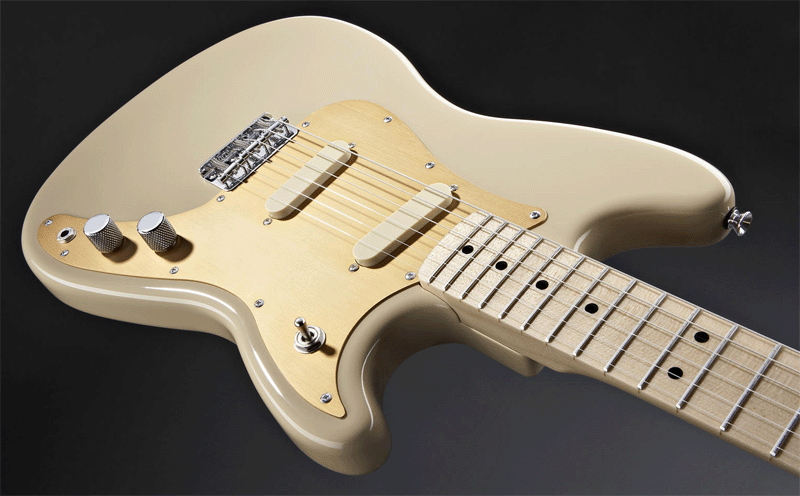 |
If we overlook this (and imagine it‘s just a bad test model), the guitar is a joy to play. But it’s not just the short scale neck and look/feel that make it so, it also sounds great. If you’re looking for a clean high treble tone, then this guitar is for you. It also sounds very nice with muted chords, it’s super silent (unlike some of the others in the series) and, to top it all off, it’s extremely light.
Just listen to the examples: Example 1 (Clean), Example 2 (Light Overdrive), Example 3 (Distortion).
60's Stratocaster
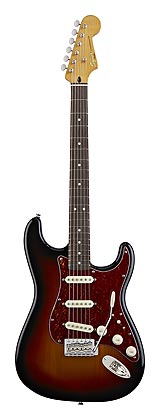 |
The Classic Vibe Stratocaster comes in two flavors: a 50’s 2-color sunburst with a maple neck and a 60’s 3-color sunburst with a rosewood fingerboard which was the one tested here.
In addition to the aforementioned color and fingerboard wood, it has the following specs: an alder body with a 1-piece maple (“C” Shape) neck, 21 medium jumbo frets, 3 single-coil Strat pickups with staggered alnico 5-magnet pole pieces. The rest is more or less standard Stratocaster fare: 25.5” (648 mm) scale, 5-position pickup switch, vintage style tremolo, etc. All hardware on this guitar is chrome.
Like the others, the finish and craftsmanship of this guitar are top-notch, and it too looks and feels great. Of course the tuning machines and other “vintage” specs could have been better, but would have no doubt cost too much. The neck and fingerboard are particularly nice, look and feel wise. The first few frets are a little too deep which sometimes can affect intonation when playing chords. It’s not as serious as with the Duo-Sonic but still can be disconcerting at times.
Acoustically it’s very resonant and balanced. Once you plug it in you’ll hear all the typical Strat sounds and colors you’d expect. The pickups have a lot of punch and ample sustain. The guitar is a little noisy (in a vintage way no doubt), but nothing too serious.
I was impressed with how good this thing sounded. My 91 US Strat was not superior in sound (made me wonder why). The medium jumbo frets and rosewood fingerboard give the player a lot of control and feel very comfortable. Plus it really looks classy…Where’s the catch? Does hardware justify the difference in price?
Anyway, judge for yourselves. Here are some examples: Example 1 (Overdrive – bridge & middle pickups), Example 2 (Funky), Example 3 (Bluesy – Neck Pickup).
No matter what your level is, or the number of Strats you already own, you shouldn’t miss the chance to test these guitars. But if your wife or girlfriend is complaining about the number of guitars you already have, then maybe you should abstain….
50's Precision Bass
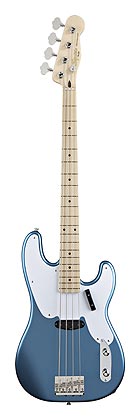 |
The Squier Classic Vibe series contains three basses: a 50’s Precision Bass, a 60’s Precision Bass, and a 60’s Jazz Bass. In this test we’ll be taking a look at the 50’s Precision Bass.
I absolutely love the way this bass looks and feels. The unique color choice, which might not be for everyone, is an eye catcher. I get a lot of positive comments every time I use it at a gig. And, as with the other models in this series, its finish and workmanship are impressive.
The specs are: basswood body (lake placid blue) with a 1-piece maple neck (C shape). It’s got 20 frets (34" – 864 mm scale) and 1 single-coil pickup with Alnico 5 magnets. 2 controls (volume and tone), a 4-saddle bridge, and open gear tuning machines. Hardware is chrome with knurled knobs.
As usual, all inferior (cheaper) hardware specs are justified by the “vintage” word. But for once they don’t seem to be an issue because there are, after all, 4 saddles, solid chrome knobs, and tuning machines that work well. This bass looks, feels, sounds, and handles like a vintage bass (in a good way). I particularly like the feel of the maple neck and the contouring of the back of the body. Thanks to the 4-saddle bridge, the string action can easily be adjusted in case of buzzing issues. The pickup can also be adjusted to the desired height thanks to the easily accessed screws.
The only problem I found was the aforementioned side-mounted jack input (like the Telecaster). The whole thing (tightly screwed and all) can be pulled out of the wood socket if your fingers are strong enough. I did a gig with this bass, and when I took a break, not having a guitar stand, I placed it in a corner with the jack still plugged in (something I unfortunately do often). The pressure of the bass’s weight against the jack almost forced the whole thing out of the socket (and this was the first time I used it). It would probably be better in the long run to replace it with an Electrosocket or other high quality socket.
As for the sound…Squier isn’t kidding when they say it’s got a “warm, earthy old-school Precision Bass tone”. The pickup hums a little when not being played, but of course it’s a “vintage” hum. This bass plays perfectly in many styles: Motown, Funk, Rock, Reggae, etc., and even Slap when the tone knob is all the way up. Here are some audio examples:
Just like the Telecaster & Stratocaster in this series, excepting the hardware, this bass easily compares with “made in Mexico” models and even US made ones and considering the price is a great deal.
Conclusion
Crafted in China but backed by Fender, these guitars and basses have the possibility of being inexpensive quality instruments “IF” Fender/Squier quality control does its job. Nevertheless, as anybody who has bought Chinese made instruments knows, it’s largely hit or miss. To be sure you’re getting a well made instrument (and yes it is possible to get some real quality stuff from China) you need to test the instruments yourself (or at least make sure the store you’re buying it from has a return policy). This is key because only then will you see if there are any flaws. So go to your nearest guitar store and check these Classic Vibe instruments out. When well made, they are really great inexpensive quality instruments. There will still be one or two hardware issues but they are easily changed, and considering the price of these instruments (average MSRP/street of $499/$299), you won’t feel scared or hesitant about making modifications. But do yourself a favor, go check this series out!
[+] Beautiful Finishes
[+] Sound
[+] Workmanship
[+] Price
[+] Duo-Sonic ultra quiet
[+] Intonation on the Telecaster
[-] Duo-Sonic: intonation and neck issues (probably a bad test model)
[-] A few hardware issues: side mounted input jacks on Tele & Precision
[-] A little noisy (Telecaster, Stratocaster, Precision)
[-] Only 3 saddles on the Telecaster & Duo-Sonic
